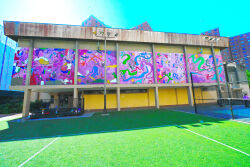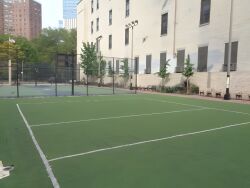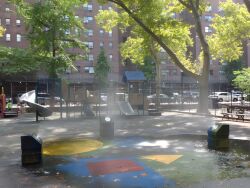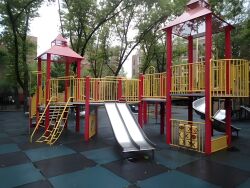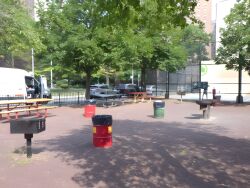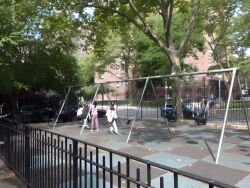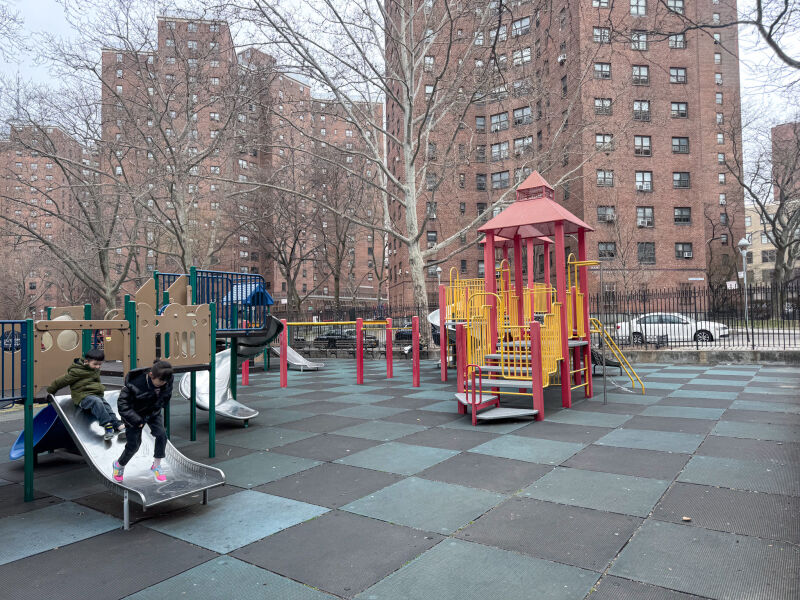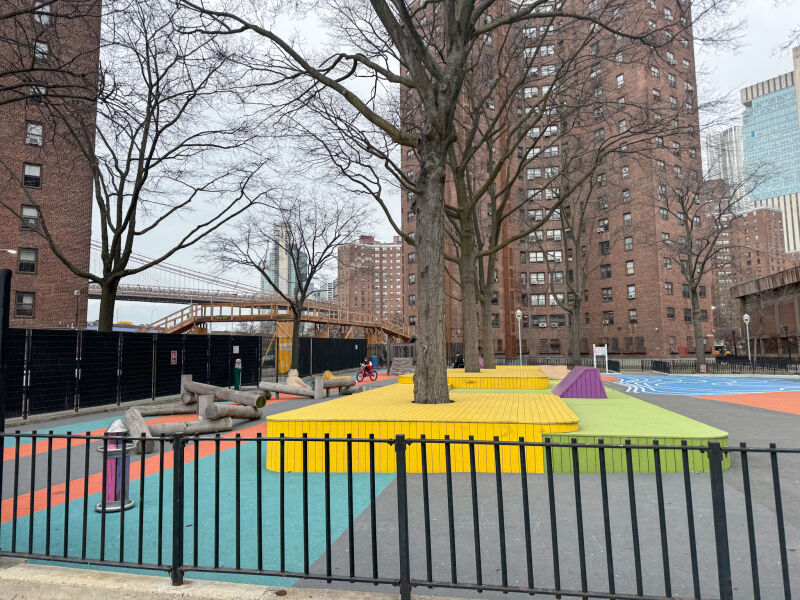Alfred E. Smith Playground
View all monuments in NYC Parks, as well as temporary public art installations on our NYC Public Art Map and Guide.
Governor Alfred E. Smith Memorial
| Artist: | Charles Keck |
| Dedicated: | June 1, 1950 |
| Location: | Catherine Street, between Cherry and Monroe Streets, fronting the Governor A.E. Smith Houses |
Artwork History
This bronze statue by Charles Keck (1875–1951) depicts Alfred Emanuel Smith (1873–1944), a Lower East Side boy who rose to the highest political office in New York State.
Smith’s life is an American success story. Known throughout his life as the “King of Oliver Street” (where he lived from 1904 to 1924) and “The Happy Warrior,” (in answer to Wordsworth’s poetic question, “Who is the happy WarriorΑ Who is he/That every man in arms should wish to beΑ”) Smith was the son of working-class Irish immigrants. He dropped out of St. James Parochial School to help support his family, and received his education in the crowded streets and political clubs of the Lower East Side. Lack of formal education did not hinder Smith from becoming a renowned New York legislator and executive. Schooled in the ways of the political machine by Tammany boss Charles F. Murphy, his wit and charm disarmed even the most formidable political adversaries, and earned him widespread public support.
In 1904, Smith was elected to his first government office as a Democratic member of the State Assembly. While serving on the Assembly, Smith co-chaired the Factory Investigating Commission with State Senator Robert F. Wagner. Together, they investigated labor conditions and passed laws to raise safety standards and limit work hours. In 1917, Smith was elected President of the Board of Aldermen. In 1918, he was elected the first Irish Catholic Governor of New York, a position he held for four two-year terms (1919-21, 1923-1929).
A loyal supporter of improvements to the Lower East Side, which he called “the old neighborhood,” Smith sponsored legislation for rent control, tenant protection, and low-cost housing. As Governor, he appointed Robert Moses (1888–1981) as Chairman of the New York State Council on Parks in 1924, and as Secretary of State in 1927.
Smith made history in 1928 as the first Irish Catholic to be nominated for President. He ran as the Democratic nominee but lost the election to Herbert Hoover, in a campaign that was tainted with anti-Catholic rhetoric and innuendo. Soon after his defeat, Smith and his family returned to New York City, with Smith continuing his career in public service as a central figure in municipal development. He supported the development of new housing and parkland that was eventually built near his birthplace, 174 South Street. The housing was to provide homes for the overpopulated Lower East Side, and to provide residents with open space and greenery on their doorstep. The Governor Alfred E. Smith Houses were erected in the early 1950s, and were named in memory of Smith, who had died in 1944.
As part of the local housing and park improvements, friends of Smith commissioned this monument. Keck depicts a full-standing figure in front of a podium on which is placed a gavel and Smith’s signature brown derby. On the rear of the granite lectern is mounted a relief sculpture representing “Sidewalks of New York,” a popular song often played at Al Smith’s campaign rallies. Ground was broken for this statue on October 14, 1949 and it was unveiled on June 1, 1950. The maquette for this sculpture is displayed in the entryway of the nearby Al Smith Recreation Center, and another bust of Smith by Keck is on display in the Al Smith Pavilion at St. Vincent’s Hospital in Greenwich Village.
Keck had a long and distinguished career as a sculptor. His other works in New York City’s parks include the Father Duffy statue (1937), Brooklyn War Memorial (1951), 61st District War Memorial (1922) at Greenwood Playground, Brooklyn, and a commemorative tablet on the rear of the Maine Monument in Columbus Circle (1935). His portrait of Smith evokes a man of the people who attained great stature yet never forgot his humble origins.
Artwork Details
| Description: | Standing figure (over life-size) before a die, right hand resting on a drapery that partially covers the die; a brown derby is on the drapery; plaques on front and two ends of die; die and figure rest on a low base; on back of die is a bas-relief |
| Architect: | Eggers & Higgins |
| Materials: | Figure, plaque, and bas-relief--bronze, die and base -- Texas pink granite |
| Dimensions: | Figure H: 9'3"; Die H: 4'6" W: 9'6" D: 2'6"; Bas-relief H: 4' W: 7'8" |
| Donor: | Governor A.E. Smith Memorial Committee |
| Cast: | 1946 |
Inscription
[front]THESE HOUSES ARE NAMED / FOR / ALFRED EMANUEL SMITH / 1873 - 1944 / SPEAKER OF THE ASSEMBLY / SHERIFF OF NEW YORK COUNTY / PRESIDENT OF THE BOARD OF / ALDERMEN / FOUR TIMES GOVERNOR OF / THE STATE OF NEW YORK / NOMINEE FOR / PRESIDENCY OF THE / UNITED STATES / THIS MEMORIAL IS THE / GIFT OF HIS FRIENDS /
[proper right]
BORN AND RAISED / IN THIS OLD EAST / SIDE AS WERE HIS / FATHER, MOTHER / WIFE AND FIVE / CHILDREN. HE/ WORKED DEVOT-/ EDLY TO MAKE IT / A BETTER AND A/ HAPPIER HOME / FOR HIS NEIGHBORS
[proper left]
HAPPY WARRIOR / FOR THE RIGHTS / OF HUMANITY HE / VOICED THE FAITH / "THE GREATEST / PRIVILEGE THAT / CAN COME TO ANY / MAN IS TO GIVE / HIMSELF TO THE / NATION WHICH / REARED HIM"
Please note, the NAME field includes a primary designation as well as alternate namingsoften in common or popular usage. The DEDICATED field refers to the most recent dedication, most often, butnot necessarily the original dedication date. If the monument did not have a formal dedication, the yearlisted reflects the date of installation.
For more information, please contact Art & Antiquities at (212) 360-8163.
Check out your park's Vital Signs
Clean & Safe
Green & Resilient
Empowered & Engaged Users
Share your feedback or learn more about how this park is part of a
Vital Park System






